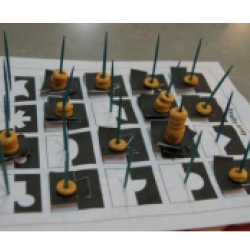Source Institutions
Source Institutions
Add to list Go to activity

In this activity (page 12), learners apply the concepts of pixilation and pointillism to the world of biomedical science. They learn how DNA microarrays and supercomputers help in disease detection by organizing large amounts of data points from our human genome. Learners discover that categories of disease can be sorted based on color-coded expression level patterns on microarrays. In particular, learners evaluate what genes are turned on and off in a patient suffering from a particular disease. Learners use Cheerios stacks to create microarrays and simulate the gene matching (hybridization) process that happens in cells. [Activity is publicly available through a web crawler capture on Archive.org.]
- 10 to 30 minutes
- 1 to 2 hours
- $5 - $10 per group of students
- Ages 11 - 14
- Activity, Lesson/Lesson Plan, Simulation
- English
Quick Guide
Materials List (per group of students)
- Play-dough
- Rolling Pin
- Cookie cutter or pizza cutter (something that allows you to shape a Play-dough rectangle approximately 8 in. x 5 in.)
- Paper plates or waxed paper (on which to place Play-dough array)
- Froot Loops or Fruity O’s cereal (fluorescence/glowing light on spots)
- Scissors
- Fruity Array Probe Sheet (Page 28)
- Fruity Array Shapes Handout (Page 29)
- Pointy toothpicks
- Colored pencils
- ASU Microarray poster/slide/overhead (Page 25)
- Array Cards, cut and laminated (Pg 26)
- Diagnosis Key (Pg 27)
- Student Sheet (Pg 23)
Subjects
-
Engineering and Technology
-
Computing
- Computer Science
- Information Technology
-
Engineering
- Bioengineering/Biomedical Engineering
- Computer Engineering
-
Technology
- Medical Technology
-
Computing
-
Life Sciences
- Cells
-
Heredity and Genetics
- Human Genetics
- DNA Structure and Function
-
Human Body
- Medicine
-
Mathematics
-
Data Analysis and Probability
- Data Analysis
- Data Collection
- Data Representation
- Representation
-
Data Analysis and Probability
-
The Nature of Technology
-
The Design Process
- Problem Solving
-
The Design Process
-
Physical Sciences
-
Chemistry
- Chemical Bonding
- Chemistry of Life
-
Chemistry
-
The Nature of Science
-
The Scientific Process
- Conducting Investigations
- Gathering Data
- Formulating Explanations
- Communicating Results
- Science as a Career
-
The Scientific Process
Informal Categories
- Computers
- Food and Cooking
Audience
To use this activity, learners need to:
- see
- see color
- read
- touch
Learning styles supported:
- Involves teamwork and communication skills
- Involves hands-on or lab activities
Other
Components that are part of this resource:
Includes alignment to state and/or national standards:
Access Rights:
- Free access
By:
Rights:
- All rights reserved, Arizona Science Center, 2012
Funding Source:
- Science Education Partnership Award, National Institutes of Health
